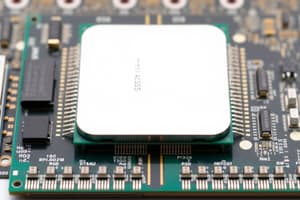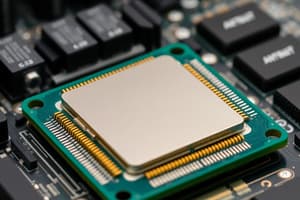Podcast
Questions and Answers
What is considered a basic building block of a computer system?
What is considered a basic building block of a computer system?
- Applications Software
- Operating System
- Peripheral Devices
- Central Processing Unit (CPU) (correct)
Which type of computer system is designed for individual use and typically runs a personal operating system?
Which type of computer system is designed for individual use and typically runs a personal operating system?
- Supercomputer
- Personal Computer (correct)
- Embedded System
- Mainframe Computer
Which of the following best describes protocols in computer systems?
Which of the following best describes protocols in computer systems?
- Standards for software development
- Rules governing the use of system resources
- Specifications for hardware components
- Agreements on data communication methods (correct)
What distinguishes a supercomputer from a regular computer system?
What distinguishes a supercomputer from a regular computer system?
Which of these is NOT typically classified as a type of computer system?
Which of these is NOT typically classified as a type of computer system?
What role do protocols play in computer systems?
What role do protocols play in computer systems?
Which of the following would NOT typically be considered a basic building block of a computer system?
Which of the following would NOT typically be considered a basic building block of a computer system?
Which type of computer system generally has the highest processing power?
Which type of computer system generally has the highest processing power?
What is one key feature of protocols and standards in computer systems?
What is one key feature of protocols and standards in computer systems?
Which of the following best describes a characteristic of distributed computing systems?
Which of the following best describes a characteristic of distributed computing systems?
Flashcards
Computer System Building Blocks
Computer System Building Blocks
The fundamental components of a computer system, including the central processing unit (CPU), memory (RAM), storage devices (hard drives, SSDs), and input/output devices (keyboard, mouse).
Types of Computer Systems
Types of Computer Systems
Different categories of computers, ranging from personal computers (desktops, laptops) to mainframes, supercomputers, and embedded systems.
Computer Protocols
Computer Protocols
Rules and standards that govern how computers communicate with each other, ensuring data transmission accuracy and reliability.
Computer Standards
Computer Standards
Signup and view all the flashcards
CPU
CPU
Signup and view all the flashcards
What does CPU do?
What does CPU do?
Signup and view all the flashcards
Storage Devices
Storage Devices
Signup and view all the flashcards
Input/Output Devices
Input/Output Devices
Signup and view all the flashcards
Study Notes
Basic Building Blocks of a Computer System
- Central Processing Unit (CPU): The "brain" of the computer, responsible for executing instructions. It fetches instructions from memory, decodes them, and performs the necessary calculations. Speed is measured in gigahertz (GHz). Different CPUs have varying architectures and instruction sets.
- Memory (RAM): Random Access Memory, used to store data and instructions that the CPU is currently using. Faster access time for the CPU. Data is lost when the computer is turned off. Measured in gigabytes (GB). Types of RAM include DDR3, DDR4, and DDR5, each with differing performance characteristics.
- Storage Devices (Hard Drives, SSDs): Used for long-term storage of files and programs. Data persists even when the computer is off. Measured in gigabytes (GB) or terabytes (TB). Different types of storage technologies (e.g., HDD, SSD) have different characteristics (speed, cost), with SSDs generally being faster and more efficient than HDDs.
- Input Devices (Keyboard, Mouse, Microphone): Used to provide data to the computer. Input devices have evolved in functionality, such as touchscreens and biometric input methods.
- Output Devices (Monitor, Printer, Speakers): Used to display or present information to the user. Output device technologies are increasingly advanced, with high-resolution displays and immersive audio systems.
- Motherboard: The main circuit board that connects all the components of the computer together. Modern motherboards support different expansion slots and interface options for diverse hardware capabilities. This includes different slots that enable connecting additional components and support various expansion cards.
- Power Supply Unit (PSU): Converts AC power to DC power for components in the system and crucial for supplying regulated voltage to the computer's components. The quality and capacity of the PSU influence the system's stability.
- Graphics Processing Unit (GPU): A specialized processor for handling image rendering and graphics processing, commonly used in gaming and multimedia applications. The increasing demand in gaming & visualization applications has led to powerful and sophisticated GPUs.
- Network Interface Card (NIC): Enables communication between the computer and other devices on a network. Ethernet and Wi-Fi are common NIC technologies.
Different Types of Computer Systems
- Personal Computers (PCs): Desktop or laptop computers designed for individual use. Wide range of configurations and functionalities. PCs can be further classified as workstations or home PCs, based on usage.
- Workstations: High-performance computers typically used for demanding tasks like graphic design, engineering, or scientific computing. More powerful processors and higher memory capacity than PCs. Workstations are designed to handle heavy computational loads and are used in varied professional situations.
- Servers: Computers designed to provide services to other computers or devices on a network. Usually run specialized software and are optimized to handle high load. Dedicated servers are designed for providing specific services.
- Embedded Systems: Microcontrollers or computers built into devices like cars, appliances, or industrial equipment. Often dedicated to a specific task, with limited resources. Purpose-built for specific applications, ranging from automotive to industrial automation.
- Supercomputers: Highest-performance computers available, used for tasks requiring massive computation capabilities, like weather forecasting or scientific simulations. Exceedingly large amount of memory and processing ability for complex computational tasks.
- Mobile Devices: Smartphones, tablets, and other handheld devices. These integrate many functions of a computer system into a compact and portable form factor.
- Cloud Computing Systems: Distributing computer processing, storage, and networking resources over a network, rather than relying on a single physical computer system. This allows for shared access and higher scalability.
Protocols and Standards in Computer Systems
- Protocols: Rules and standards that govern communication between different components or systems. Examples include TCP/IP (Transmission Control Protocol/Internet Protocol), which is fundamental for data transmission over the internet. Other key protocols include UDP (User Datagram Protocol) and specialized protocols for specific applications.
- Standards: Formal specifications that define how things should be designed and implemented. These ensure compatibility and interoperability among different systems and components like electrical specifications, data formats, and communications standards.
- Network Protocols: Sets of rules dictating how devices communicate on a network (Ethernet, WiFi, etc.). These protocols allow different devices and operating systems to communicate. This ensures consistency and compatibility within various network infrastructures.
- Operating Systems (OS): Software that manages hardware resources and provides a platform for applications to run. This OS (Windows, macOS) acts as mediator between the hardware and the application. Operating systems use various protocols to manage processes, memory, and other system resources.
- File Formats: Specifications defining how data is stored ( .jpg, .pdf, .txt formats). Standardize how data can be handled and viewed. This supports cross-platform compatibility and data exchange.
- Hardware standards: Standards that define how components should be designed and integrated, ensuring compatibility across different products. Examples include PCI (Peripheral Component Interconnect) and SATA (Serial Advanced Technology Attachment). This facilitates the development and seamless integration of various components.
- Application Programming Interfaces (APIs): Rules and standards defined by software developers so different programs can communicate. APIs enable programs to interact and interact without needing complete knowledge of their workings. APIs are crucial for building software systems that are interconnected and modular.
- Security Standards: Protocols and standards that ensure the safety and integrity of information within the computer system. TLS/SSL protocols ensure secure communication channels.
Studying That Suits You
Use AI to generate personalized quizzes and flashcards to suit your learning preferences.




